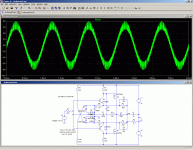They are pull up/downWhat is the role of R2 and R10?
The diodes as bias reference work fine:
Attachments
How does it perform irl?
Difficult to tell: other than a dummy load, I tested it on an unboxed 4" speaker.
In those conditions, it sounded normal....
yah, I hate to be a party-poop but I really wouldn't call that much of a listening test and review. Not much irl measured data either...
I was just curious to it's actual performance, nothing more, nothing less. 🙂
I was just curious to it's actual performance, nothing more, nothing less. 🙂
Who cares?yah, I hate to be a party-poop but I really wouldn't call that much of a listening test and review. Not much irl measured data either...
Just look at the title:
If you want to take things more seriously, you can always do it by yourself, and have some fun in the process 😛Just for fun: UcD on a shoestring
Sorry for showing an interest in your build.
It looked like a nice little piece of work and it would have been interesting to know more.
It looked like a nice little piece of work and it would have been interesting to know more.
Thanks for your interest, but don't take the matter too seriously: I don't, I am basically just a buffoon 
In fact, I had already dismantled my prototype to make room for the next one.

In fact, I had already dismantled my prototype to make room for the next one.
I guess it can be surprisingly good with optimised component selection! Not THD champion, but pleasant.
Hi Elvee
Thumbs up. Super cool. Very good thinking 🙂
Could be really cool for a 2 way PC speaker, with electronic filter ..... and a lot of other applications
Thanks for sharing.
Best Regards Baldin
Thumbs up. Super cool. Very good thinking 🙂
Could be really cool for a 2 way PC speaker, with electronic filter ..... and a lot of other applications
Thanks for sharing.
Best Regards Baldin
- Status
- Not open for further replies.
- Home
- Amplifiers
- Class D
- Just for fun: UcD on a shoestring
